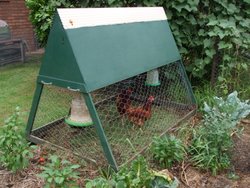
When we last saw our hero, the old chook tractor had died and he needed a new one........quickly!
All melodrama aside, here is what I did. In many respects it was similar to the old one, it was A-frame in shape and had a footprint the exact size of most of our veggie beds, but it also had some significant differences –
• It was built of much lighter materials so that it could be easily shifted by two people, even if one was a short and lightly built (but enormously cute) female.
• Rather than have an opening on one end, the inside area is accessible through a hinged panel running the length of one side.
• There are two nesting areas rather than one.
• It is painted all over to extend its life.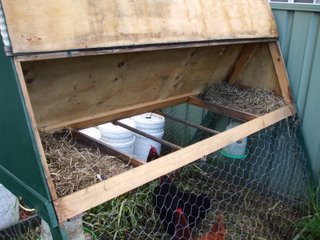
The main part of the A-frame is constructed from DAR pine that is 70mm x 19mm because it is light, cheap and easily available, and this is how I made it –
1. I set out the base to be 1975mm long by 1310mm wide, using some steel angles to attach the four members and form the base. I cut four more members to 1490mm long and trimmed the ends to the correct angle so they could form the A-frame ends. I attached them to the base and together at the apex by using some light steel braces and screws. A ridge beam of the same size pine was screwed into the apex of the A-frame through the brace and the basic shape was complete.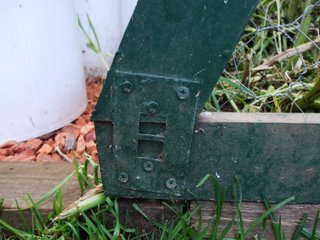
2. To brace the structure and provide a base to attach the laying areas and perches on, 730mm up from the base along the A-frame uprights I put in a 70mm wide by 19mm deep cut out in each of the uprights to allow me to fit in a mid-rail. To make the cut-outs I just drew the measurements onto the upright, cut 70mm in with a tennon saw and then chiselled out the waste. I could then fit in the brace and screw it in to secure it. At the same height I put in a timber brace on each end to take the lifting handles.
3. Using the same process I put in another brace 460mm above the first one so that I could attach the peak cover. To make the peak waterproof I didn’t just want to form a timber peak and then seal it, I got hold of some colourbond mini-orb that I could get cheaply, the sheet was 2 metres long by 1 metre wide, so taking my angle grinder with a cutting blade (wearing eye and ear protection of course) and cut 400mm off the width of the sheet. This would cover the entire length of the tractor and (when bent in half lengthwise) extend 200mm down each side, giving a waterproof peak to the tractor. 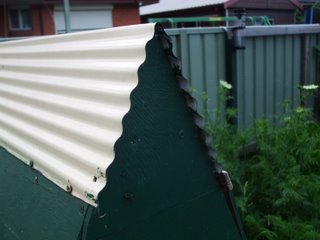
4. I could then start to fill in the structure around the laying area. I did this by screwing 3 ply to what would become the back side of the tractor to the top and bottom braces as well as the sides of the A-frame. I then cut some plywood to fit the top part of the A-frame ends and screwed that into place. After having lots of fun trying to bend the mini-orb to the correct angle to go over the top of the A-frame (it took two of us jumping on the damn thing to accomplish it) I fitted it in place and screwed it down.
5. I then fitted the floor in each end of the covered area to act as laying boxes by cutting two squared of 5 ply 500mm long x 600mm wide, then cutting out a 19mm x 70mm notch in each rear corner to allow the floor to sit back all the way to the rear of the nesting area. To attach the ply to the mid rail I used four small L-shaped steel brackets , bent into an acute angle so that they fitted flush onto the slope of the mod rail. Four screws, two into the mid rail and two into the base itself secured the bases to the mid rail. 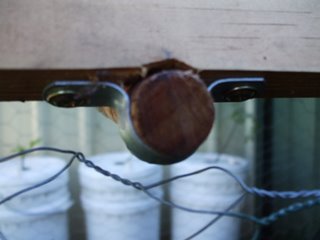
6. Next came the perches, two of which were made out of a length of recycled broom handle, attached to the mid rail by an electrical conduit clip screwed onto each end, a notch had to be cut in the angle of the mid-rail to allow the perch to fit solidly.
7. Before fitting in the main access door I had to fit the chook wire around the open bottom of the tractor. Using side cutters I cut the wire to side for each of the four openings (2 x sides and 2 x ends). The wire is quite sharp and you might want to use gloves to prevent unnecessary damage to your hands and prevent your kids learning any bad words before they absolutely need to. Once cut to shape I pulled out a stapler I’d been given and using some long, U-shaped staples I attached the wire to the tractor framework.
8. Once the rest was assembled I could put on the access door. This was just a piece of 3 ply 2000mm x 500mm that I attached to the top rail by three small hinges, which proved to be totally inadequate for the job, *sigh*. After they gave up the ghost I did what I should have done in the first place and used a 1500mm length of piano hinge that I had floating around the garage.
9. The tractor was now complete except for a coat of lovely British racing green paint so that it fits in with the rest of the back yard and I placed a ring bolt on the underside of the centre of each laying platform, to which a feeder and waterer are attached.
The chooks seemed excited to be in their new home, well as excited as a chook can get I suppose. Originally the tractor held four chooks, two Australorp and two Rhode Island Reds, but with the passing of one of the Austrlorps there are now only three although they still seem to be capable of mass destruction in their allotted two weeks on each patch and we still get plenty of eggs.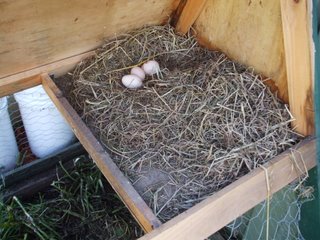
One difficulty that has subsequently surfaced is that if something panics the chooks and they squawk and flap everywhere, the top of the wire netting can come loose and let one out, requiring the wire to be re-attached more firmly by small nails. While I was striving to be as light as possible, a more substantial attachment for the wire is a good idea.
The new one is considerably lighter than the old one but my lovely partner in the sustainable life still has a bit of trouble with it, so we have evolved a technique where she gets one end with a trolley and I lift the other end. It gets us where we need to go. I have considered attaching wheels but more often than not the tractor is shifted sideways to the next veggie bed (which I can do by myself) and the wheels would be more a hindrance than a help, but your set up will be different and you might want to think about adding wheels.



